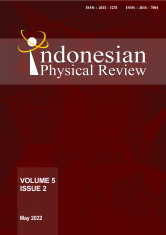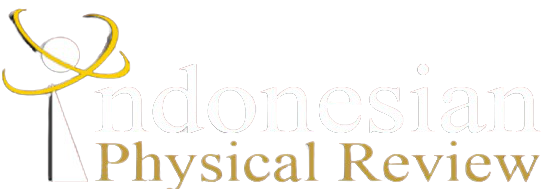FABRICATION OF PVA/TiO2 NANOFIBERS BY ELECTROSPINNING METHOD AS PHOTOCATALYTIC DEGRADATIO
DOI:
10.29303/ipr.v5i2.145Downloads
Abstract
The nanofiber fabrication process was optimized to determine the effect of stress variations on the morphology and diameter of the nanofibers produced for the absorption of methylene blue dye in water. PVA/TiO2 nanofibers were made using the electrospinning method. The nanofiber fabrication process begins by dissolving 10% PVA with the addition of 0.05 g of TiO2 nanoparticles, the collector tip distance is 15 cm with varying voltages of 12, 15, and 18 kV. PVA/TiO2 nanofiber characterization was carried out using FTIR, SEM, EDS, and UV-Vis Spectrophotometer. The results showed success in forming PVA/TiO2 nanofibers. The nanofibers show a fibrous structures with a diameter of 252 nm for PVA and 237 nm for PVA/TiO2 with a uniform surface and contained TiO2 nanoparticles scattered within the nanofibers. The photocatalytic testing within 5 hours shows that PVA nanofibers can degrade up to 39.29% of the methylene blue dye, while TiO2 powder is up to 55.48%. Hence, the PVA/TiO2 nanofibers can degrade the dye up to 97.02%. The results of good transparency on the UV-Vis Spectrophotometer test are shown in the visible light region caused by the uniform distribution of TiO2 nanoparticles in the nanofiber.
Keywords:
Nanofiber PVA TiO2 Electrospinning PhotocatalyticReferences
Wintgens, T., Salehi, F., Hochstrat, R., & Melin, T. (2008). Emerging contaminants and treatment options in water recycling for indirect potable use. Water Science and Technology, 57(1), 99–107. Doi: https://doi.org/10.2166/wst.2008.799
Andersson, K., Dickin, S., & Rosemarin, A. (2016). Towards “sustainable†sanitation: Challenges and opportunities in urban areas. Sustainability (Switzerland), 8(12). Doi: https://doi.org/10.3390/su8121289
Aliah, H., Arutanti, O., Masturi, Setiawan, A., Sustini, E., Budiman, M., & Abdullah, M. (2011). Optimization of coating temperature of TiO2 nanoparticles on the polypropylene copolymer surface for photodegradation of methylene blue. AIP Conference Proceedings, 1415, 155–158. Doi: https://doi.org/10.1063/1.3667245
Choi, J., Park, H., & Hoffmann, M. R. (2010). Combinatorial doping of TiO2 with platinum (Pt), chromium (Cr), vanadium (V), and nickel (Ni) to achieve enhanced photocatalytic activity with visible light irradiation. Journal of Materials Research, 25(1), 149–158. Doi: https://doi.org/10.1557/jmr.2010.0024
Yin, B., Wang, J. T., Xu, W., Long, D. H., Qiao, W. M., & Ling, L. C. (2013). Preparation of TiO2/mesoporous carbon composites and their photocatalytic performance for methyl orange degradation. Xinxing Tan Cailiao/New Carbon Materials, 28(1), 47–54. Doi: https://doi.org/10.1016/S1872-5805(13)60064-5
Jeong, T., & Lee, S. (2019). Photocatalytic Self-cleaning by Nanocomposite Fibers Containing Titanium Dioxide Nanoparticles. Fibers and Polymers, 20(1), 25–34. Doi: https://doi.org/10.1007/s12221-019-8678-5
Nugroho, I. A. (2011). Deposisi Lapisan Tipis Titania Dan Pembuatan Sistem Pengolah Air Limbah Organik Mengunakan Material Fotokatalis Titania (TiO2). Jurusan Fisikan Fakultas MIPA, Sarjana S1, 1–8.
Hikmawati, D., Rohmadanik, A. R., Putra, A. P., Siswanto, & Aminatun. (2018). The Effect of Aloe vera Extract Variation in Electrospun Polyvinyl Alcohol (PVA)-Aloe vera-Based Nanofiber Membrane. Journal of Physics: Conference Series, 1120(1). Doi: https://doi.org/10.1088/1742-6596/1120/1/012096.
Khulbe, K. C., & Matsuura, T. (2019). Art to use electrospun nanofibers/nanofiber based membrane in waste water treatment, chiral separation and desalination. Journal of Membrane Science and Research, 5(2), 100–125. Doi: https://doi.org/10.22079/JMSR.2018.87918.1197
Shirazi, M. M. A., & Bazgir, S. (n.d.). Electrospun Nanofibrous Membranes for Water Treatment.
Ding, B., Kim, H. Y., Lee, S. C., Shao, C. L., Lee, D. R., Park, S. J., Kwag, G. B., & Choi, K. J. (2002). Preparation and characterization of a nanoscale poly(vinyl alcohol) fiber aggregate produced by an electrospinning method. Journal of Polymer Science, Part B: Polymer Physics, 40(13), 1261–1268. Doi: https://doi.org/10.1002/polb.10191
Sousa, A. M. M., Souza, H. K. S., Uknalis, J., Liu, S. C., Gonçalves, M. P., & Liu, L. (2015). Electrospinning of agar/PVA aqueous solutions and its relation with rheological properties. Carbohydrate Polymers, 115, 348–355. Doi: https://doi.org/10.1016/j.carbpol.2014.08.074
Rwei, S. P., & Huang, C. C. (2012). Electrospinning PVA solution-rheology and morphology analyses. Fibers and Polymers, 13(1), 44–50. Doi: https://doi.org/10.1007/s12221-012-0044-9
Nasikhudin, Ismaya, E. P., Diantoro, M., Kusumaatmaja, A., & Triyana, K. (2017). Preparation of PVA/TiO2 Composites Nanofibers by using Electrospinning Method for Photocatalytic Degradation. IOP Conference Series: Materials Science and Engineering, 202(1). Doi: https://doi.org/10.1088/1757-899X/202/1/012011
Mohammed Lot, N., Rashid, S. N. M., Jais, U. S., & Abd Rahman, M. K. (2015). Effect of Mixed-Phase TiO2/PVA Nanofibers on the Degradation on Methyl Orange. Advanced Materials Research, 1107, 353–358. Doi: https://doi.org/10.4028/www.scientific.net/amr.1107.353
Kurian, S., Amrita, C., Raguram, T., & Rajni, K. S. (2019). Preparation and Characterisation of PVA+TiO2 Nanofiber by Electrospinning Technique. IOP Conference Series: Materials Science and Engineering, 577(1). Doi: https://doi.org/10.1088/1757-899X/577/1/012077
Patil, J. V., Mali, S. S., Kamble, A. S., Hong, C. K., Kim, J. H., & Patil, P. S. (2017). Electrospinning: A versatile technique for making of 1D growth of nanostructured nanofibers and its applications: An experimental approach. Applied Surface Science, 423, 641–674. Doi: https://doi.org/10.1016/j.apsusc.2017.06.116
Costa, R. G. F., Ribeiro, C., & Mattoso, L. H. C. (2010). Morphological and photocatalytic properties of PVA/TiO2 nanocomposite fibers produced by electrospinning. Journal of Nanoscience and Nanotechnology, 10(8), 5144–5152. Doi: https://doi.org/10.1166/jnn.2010.2405
Wahyudi, T., & Sugiyana, D. (2011). Pembuatan Serat Nano Menggunakan Metode Electrospinning. Arena Tekstil, 26(1), 29–34. Doi: https://doi.org/10.31266/at.v26i1.1439
Sari, T. I. (2018). Optimasi Nanofiber Hasil Electrospinning.
Lou, L., Kendall, R. J., & Ramkumar, S. (2020). Comparison of hydrophilic PVA/TiO2 and hydrophobic PVDF/TiO2 microfiber webs on the dye pollutant photo-catalyzation. Journal of Environmental Chemical Engineering, 8(5), 103914. Doi: https://doi.org/10.1016/j.jece.2020.103914
Susiani, S., & Harsojo, H. (2017). Fabrikasi Fiber PVA yang Memuat Partikel TiO2 Anatase Dengan Metode Elektrospining Dan Karakteristiknya. Jurnal Ilmu Fisika | Universitas Andalas, 9(1), 33–42. Doi: https://doi.org/10.25077/jif.9.1.33-42.2017
Ben Naceur, J., Gaidi, M., Bousbih, F., Mechiakh, R., & Chtourou, R. (2012). Annealing effects on microstructural and optical properties of Nanostructured-TiO2 thin films prepared by sol-gel technique. Current Applied Physics, 12(2), 422–428. Doi: https://doi.org/10.1016/j.cap.2011.07.041
Ramesh, S., Kim, H. S., Sivasamy, A., & Kim, J. H. (2018). Synthesis of Octa(maleimidophenyl) silsesquioxane–SiO2/TiO2 Hybrid Nanocomposites: Adsorption Behavior for the Removal of an Organic Methylene Blue Dye and Antimicrobial Activity against Pathogens. Polymer - Plastics Technology and Engineering, 57(3), 185–195. Doi: https://doi.org/10.1080/03602559.2017.1320716
Nasikhudin, Diantoro, M., Kusumaatmaja, A., & Triyana, K. (2020). Enhancing photocatalytic performance by sonication and surfactant addition on the synthesis process of PVA/TiO2 nanofibers membranes by electrospinning method. AIP Conference Proceedings, 2251. Doi: https://doi.org/10.1063/5.0017654
Togas, C., Wuntu, A. D., & Koleangan, H. S. J. (2014). Fotodegradasi Zat Warna Metanil Yellow Menggunakan Fotokatalis TiO2-Karbon Aktif. Jurnal MIPA, 3(2), 87. Doi: https://doi.org/10.35799/jm.3.2.2014.5857
Parkin, I. P., & Palgrave, R. G. (2005). Self-cleaning coatings. Journal of Materials Chemistry, 15(17), 1689–1695. Doi: https://doi.org/10.1039/b412803f
Allen, N. S., Mahdjoub, N., Vishnyakov, V., Kelly, P. J., & Kriek, R. J. (2018). The effect of crystalline phase (anatase, brookite and rutile) and size on the photocatalytic activity of calcined polymorphic titanium dioxide (TiO2). Polymer Degradation and Stability, 150, 31–36. https://doi.org/10.1016/j.polymdegradstab.2018.02.008
Vahid Salimian Rizi. (2019). Ce Pte Us Pt. Materials Research Express, 0–12.
Abdullah, O. G., Aziz, S. B., & Rasheed, M. A. (2016). Structural and optical characterization of PVA:KMnO4 based solid polymer electrolyte. Results in Physics, 6, 1103–1108.
Tian, Y., & Tatsuma, T. (2005). Mechanisms and applications of plasmon-induced charge separation at TiO2 films loaded with gold nanoparticles. Journal of the American Chemical Society, 127(20), 7632–7637. Doi: https://doi.org/10.1021/ja042192u
License

This work is licensed under a Creative Commons Attribution-NonCommercial-ShareAlike 4.0 International License.
Authors who publish with Indonesian Physical Review Journal, agree to the following terms:
- Authors retain copyright and grant the journal right of first publication with the work simultaneously licensed under a Creative Commons Attribution-ShareAlike 4.0 International Licence (CC BY SA-4.0). This license allows authors to use all articles, data sets, graphics, and appendices in data mining applications, search engines, web sites, blogs, and other platforms by providing an appropriate reference. The journal allows the author(s) to hold the copyright without restrictions and will retain publishing rights without restrictions.
- Authors are able to enter into separate, additional contractual arrangements for the non-exclusive distribution of the journal's published version of the work (e.g., post it to an institutional repository or publish it in a book), with an acknowledgment of its initial publication in Indonesian Physical Review Journal.
- Authors are permitted and encouraged to post their work online (e.g., in institutional repositories or on their website) prior to and during the submission process, as it can lead to productive exchanges, as well as earlier and greater citation of published work (See The Effect of Open Access).





